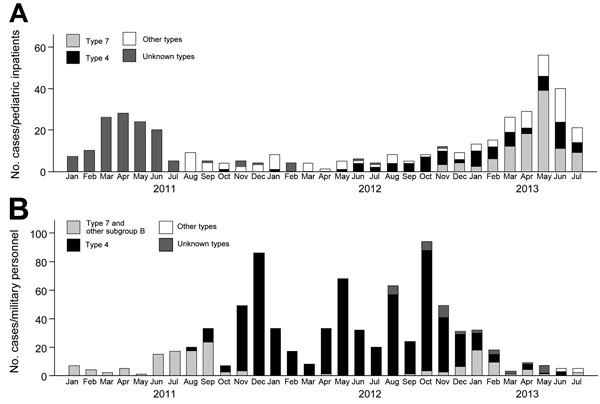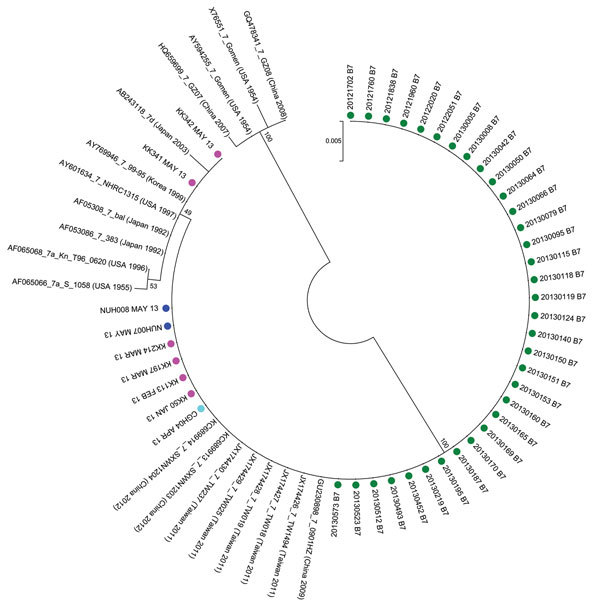Abstract
During November 2012–July 2013, a marked increase of adenovirus type 7 (Ad7) infections associated with severe disease was documented among pediatric patients in Singapore. Phylogenetic analysis revealed close genetic links with severe Ad7 outbreaks in China, Taiwan, and other parts of Asia.
Keywords: Human adenovirus, viruses, Ad7, outbreak, Asia, China, Singapore, Malaysia, invasive disease, death, mechanical ventilation
The number of pediatric inpatients increased from 32 during January–July 2012 to 200 cases during January–July 2013 (Figure 1).
Figure 1.

Number of adenovirus cases by month, January 2011–July 2013, Singapore. A) The first confirmed case of adenovirus type 7 was reported in November 2012 in KK Women’s and Children’s Hospital. The number of human adenovirus cases among the pediatric inpatient population increased and peaked in May 2013. B) A retrospective examination of the military surveillance data revealed the first appearance of adenovirus type 7 among military personnel in September 2012 and a small increase and decline over the next few months.
(Table 1). A total of 54 patients had invasive infections and 134 had noninvasive infections (Table 2).
Table 1. Demographics and clinical features of 188 hospitalized children with adenovirus, by age group, Singapore*.
| Characteristics | Values |
|---|---|
Table 2. Number and percentages of 188 hospitalized pediatric adenovirus case-patients with noninvasive and invasive infection, by key characteristics, and risk factors associated with invasive infection, Singapore*.
| Characteristics | Noninvasive infection, n = 134 | Invasive infection, n = 54 | Univariate analysis |
Multivariate analysis† |
|||
|---|---|---|---|---|---|---|---|
| Crude OR (95% CI) | p value | Adjusted OR (95% CI) | p value | ||||
(GenBank accession nos. KP729815–KP729824) (Figure 2)
Figure 2.

Phylogenetic analysis of adenovirus type 7 (Ad7) sequences from this study based on sequenced Ad7 hexon gene hypervariable regions 1–6 (Ad7 reference Gomen AY594255 hexon gene nt 324 to 1123). The phylogenetic relationships between Ad7 isolates in this study were inferred by using the maximum-likelihood method based on the Tamura-Nei model (8). Initial trees for the heuristic search were obtained by applying the neighbor-joining method to a matrix of pairwise distances estimated by using the maximum-composite likelihood approach. Tree is drawn to scale; branch lengths are measured in the number of substitutions per site, the rate of which was assumed to be uniformly distributed. The analysis involved 63 nt sequences. Green indicates isolates from military personnel, dark blue indicates isolates from patients in National University Hospital, pink indicates isolates from patients in KK Women’s and Children’s Hospital, and light blue indicates isolates from patients in Changi General Hospital. The sequence labeled as “AY594255_7_Gomen (USA 1954)” represents 1 of the published Gomen sequences (AY594255). “_7” is added to GenBank accession numbers to denote that these are Ad7 sequences. All other strains shown are published Ad7 reference isolates. Phylogenetic analyses were conducted by using MEGA6 (9). KK341 and KK342 had a single thymine-to-cytosine mutation (Ad7 reference Gomen AY594255 hexon gene nt 780). The remaining 41 isolates from Singapore had 100% nucleotide identity.
References
Footnotes
Suggested citation for this article: Ng OT, Thoon KC, Chua HY, Tan NWH, Chong CY, Tee NWS, et al. Severe pediatric adenovirus 7 disease in Singapore linked to recent outbreaks across Asia. Emerg Infect Dis. 2015 Jul [date cited]. http://dx.doi.org/10.3201/eid2107.141443
References
- 1.Lynch JP III, Fishbein M, Echavarria M. Adenovirus. Semin Respir Crit Care Med. 2011;32:494–511. PubMed 10.1055/s-0031-1283287 [DOI] [PubMed] [Google Scholar]
- 2.Tsou TP, Tan BF, Chang HY, Chen WC, Huang YP, Lai CY, et al. Community outbreak of adenovirus, Taiwan, 2011. Emerg Infect Dis. 2012;18:1825–32. PubMed 10.3201/eid1811.120629 [DOI] [PMC free article] [PubMed] [Google Scholar]
- 3.Yu P, Ma C, Nawaz M, Han L, Zhang J, Du Q, et al. Outbreak of acute respiratory disease caused by human adenovirus type 7 in a military training camp in Shaanxi, China. Microbiol Immunol. 2013;57:553–60. PubMed 10.1111/1348-0421.12074 [DOI] [PMC free article] [PubMed] [Google Scholar]
- 4.Yusof MA, Rashid TR, Thayan R, Othman KA, Hasan NA, Adnan N, et al. Human adenovirus type 7 outbreak in police training center, Malaysia, 2011. Emerg Infect Dis. 2012;18:852–4. PubMed 10.3201/eid1805.110865 [DOI] [PMC free article] [PubMed] [Google Scholar]
- 5.Tan XQ, Zhao X, Lee VJ, Loh JP, Tan BH, Koh WH, et al. Respiratory viral pathogens among Singapore military servicemen 2009–2012: epidemiology and clinical characteristics. BMC Infect Dis. 2014;14:204. PubMed 10.1186/1471-2334-14-204 [DOI] [PMC free article] [PubMed] [Google Scholar]
- 6.Lee VJ, Chen MI, Yap J, Ong J, Lim WY, Lin RT, et al. Comparability of different methods for estimating influenza infection rates over a single epidemic wave. Am J Epidemiol. 2011;174:468–78. PubMed 10.1093/aje/kwr113 [DOI] [PMC free article] [PubMed] [Google Scholar]
- 7.Lu X, Erdman DD. Molecular typing of human adenoviruses by PCR and sequencing of a partial region of the hexon gene. Arch Virol. 2006;151:1587–602. PubMed 10.1007/s00705-005-0722-7 [DOI] [PubMed] [Google Scholar]
- 8.Tamura K, Nei M. Estimation of the number of nucleotide substitutions in the control region of mitochondrial DNA in humans and chimpanzees. [PubMed</jrn>]. Mol Biol Evol. 1993;10:512–26. [DOI] [PubMed] [Google Scholar]
- 9.Tamura K, Stecher G, Peterson D, Filipski A, Kumar S. MEGA6: Molecular Evolutionary Genetics Analysis version 6.0. Mol Biol Evol. 2013;30:2725–9. PubMed 10.1093/molbev/mst197 [DOI] [PMC free article] [PubMed] [Google Scholar]
- 10.Tang L, Wang L, Tan X, Xu W. Adenovirus serotype 7 associated with a severe lower respiratory tract disease outbreak in infants in Shaanxi Province, China. Virol J. 2011;8:23. PubMed 10.1186/1743-422X-8-23 [DOI] [PMC free article] [PubMed] [Google Scholar]
- 11.Erdman DD, Xu W, Gerber SI, Gray GC, Schnurr D, Kajon AE, et al. Molecular epidemiology of adenovirus type 7 in the United States, 1966–2000. Emerg Infect Dis. 2002;8:269–77. PubMed 10.3201/eid0803.010190 [DOI] [PMC free article] [PubMed] [Google Scholar]
- 12.Li QG, Zheng QJ, Liu YH, Wadell G. Molecular epidemiology of adenovirus types 3 and 7 isolated from children with pneumonia in Beijing. J Med Virol. 1996;49:170–7. PubMed [DOI] [PubMed] [Google Scholar]
- 13.Kim YJ, Hong JY, Lee HJ, Shin SH, Kim YK, Inada T, et al. Genome type analysis of adenovirus types 3 and 7 isolated during successive outbreaks of lower respiratory tract infections in children. J Clin Microbiol. 2003;41:4594–9. PubMed 10.1128/JCM.41.10.4594-4599.2003 [DOI] [PMC free article] [PubMed] [Google Scholar]
- 14.Gray GC, Setterquist SF, Jirsa SJ, DesJardin LE, Erdman DD. Emergent strain of human adenovirus endemic in Iowa. Emerg Infect Dis. 2005;11:127–8. PubMed 10.3201/eid1101.040484 [DOI] [PMC free article] [PubMed] [Google Scholar]
- 15.Noda M, Yoshida T, Sakaguchi T, Ikeda Y, Yamaoka K, Ogino T. Molecular and epidemiological analyses of human adenovirus type 7 strains isolated from the 1995 nationwide outbreak in Japan. [PubMed>]. J Clin Microbiol. 2002;40:140–5. [DOI] [PMC free article] [PubMed] [Google Scholar]


